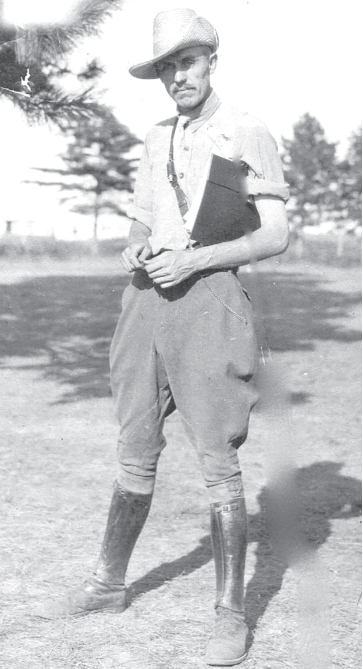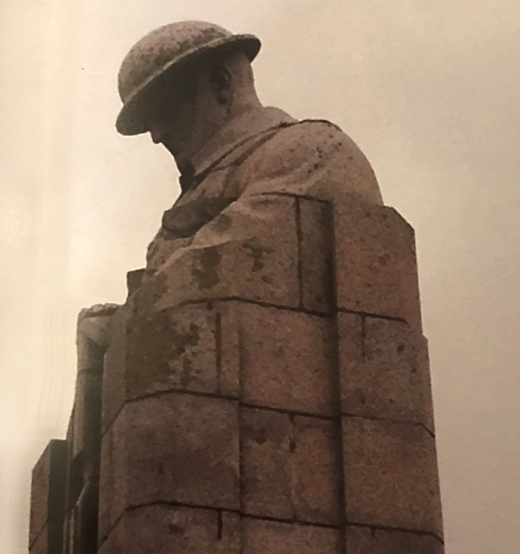
While I did all of the initial research for my Beneath the Alders series and for the first book in the series, The Innocent, I was greatly assisted in completing The Beleaguered and The Mending by the research skills of my good friend Colleen Mahoney, a pre-maturely retired librarian. In this article, Colleen answered specific questions I recently posed about the members of the Canadian Expeditionary Force whose 1915 letters from the Front are described in the article “Letters from the Front”.
Lynne: The May 13, 1915 issue of The Conservator, the local Brampton paper, reported that Lieutenant Reginald Conover missed a large battle as he had been wounded some weeks earlier and was in hospital. Did he return to the front? What became of him?
Colleen: He returned to active duty but served only a short time before succumbing to illness resulting from exposure. Being unfit to continue to serve, in January 1916, he was given two months leave to recuperate, a period he chose to take at home in Canada. He was given a hero’s welcome on his return to Brampton being met at the train station by the mayor, members of counsel and the officers and members of the 126th Battalion stationed at Brampton, a band and many citizens. He was escorted to the Armories “where Mayor Milner in a felicitous address welcomed him on behalf of the Town.”
After some time recuperating from an illness of the lungs he returned to service as an instructor with the 1st Depot Battalion, 2nd Central Ontario Regiment. By the time he was discharged from the Forces in 1918, he had risen to the rank of Major.
Major Conover must have had quite a sense of duty because he became active again when the Second World War broke out. He commanded the 2nd Battalion on Home Service (No. 24 Basic Training Centre) in Canada where he concentrated his efforts on recruiting and training men for service in all branches of the armed forces.
He went on to have a long and illustrious career with the 36th Peel Regiment following the war serving in various capacities including Commander from 1939-42. He eventually rose to the rank of Honorary Colonel. He was awarded the Order of the British Empire for volunteer service and was present for the Lorne Scots’ 100th anniversary mess dinner in 1964 before passing away in 1969.

Lynne: In a letter published in May 1915 another Brampton Private, Sydney Parbery, of Christ Church Brampton, describes a battle that began the morning of April 23rd. Parbery reported that of the 11,000 men who went into the battle only 140 came out safe and sound. George Howell was killed and W. Palmer was wounded. Both were Brampton boys. Parbery himself was wounded and was writing the letter from hospital while he awaited x-rays. Were the other letter writers referred to in this newsletter lost in that battle? What was their fate?
Colleen: The battle that was referred to in the letter was the Second Battle of Ypres. Of the five letter writers we have been able to conclusively identify, none were not lost at Ypres but two were wounded (see below). The other three did not take part in the battle because they were in hospital recovering from various afflictions they incurred prior to the battle. Those afflictions were clearly a blessing in disguise given the losses the 4th Battalion sustained.
It is a stark illustration of just how dangerous all facets of war are – not just battles. Trench warfare itself posed countless dangers which we wouldn’t necessarily think would be severe hazards. Trenches were dirty and infested with rats, flies and lice, leading to a number of different diseases: trench foot (an infection caused by long periods of being exposed to the cold and damp), trench fever (an infection caused by louse feces), dysentery, influenza and cholera, to name a few. When the weather was cold it was difficult to stay warm and soldiers often lost toes or fingers to frostbite. In addition, a soldier’s duties when not actually taking part in battle, could include repairing trenches, cleaning weapons, moving supplies, etc. All of these activities come with risk.
(a) Arthur Makepeace
Arthur was wounded with a gunshot wound to his right hand at Ypres. Originally a private, he soon became a Lance Corporal – a rank in which he was then superior to other privates in his unit. He too battled with illness common in the trenches (typhoid and enteric problems) until was discharged from duty in 1918. His records show that his conduct and character were “very good”.
(b) Frank Stewart Rutherford
Frank was wounded in the right knee at Ypres. He survived the entire war before he was “demobbed” in February of 1919. Before enlisting, he was a civil engineer with skills that lent itself to building and maintaining trenches. After dealing with medical issues that dogged him for much of 1915, he was assigned to the Trench Warfare School in England, where he acted as an instructor and was eventually seconded to the Imperial Munitions Board. At some point, he found time to woo a girl because he was married in April of 1918.
(c) Henry T. Robins
Henry was not wounded at Ypres, as he was in hospital at the time of the battle recovering from skin disease related to living in the trenches. He spent most of his war in the trenches but his tour was short lived. He was concussed during a battle, which caused deafness and disability, and was eventually discharged in October of 1916 for medical reasons.
(d) Reginald Conover
Reginald was not part of the Ypres defensives because he was recovering in the hospital from a wound caused by a misfired rifle grenade detonator he was handling while on duty but not taking place in an actual battle.
(e) Jack Leslie Pagan
Jack did not participate in the battle because he was in hospital recovering from influenza. He was 19 years old when he enlisted and worked as a printer at the Copeland - Chatterson Company in Brampton. He must have been quite pleased to discover he would be spending the winter in Salisbury Plain. He was born in Dorset, England and his mother (originally listed as his next of kin) was residing in Salisbury. I’m sure he must have been one of the lucky ones and had home cooked meals from time to time. He, too, found time to woo a girl while overseas and was married to Eliza in 1917. He spent the better part of the war stationed in Shorncliffe and Seaford, England after suffering recurring bouts of bronchitis. He returned home in 1918 having made his way up the ranks from private to sergeant at demobilization.
Lynne: So that was the Second Battle of Ypres. If memory serves me that was the first battle in which chlorine gas was used but Private Parbery doesn’t mention it. Why do you think that was?
Colleen: Well, I don’t know for certain but I expect, as you mentioned in your article, that it was to appease the censors. In addition, to preventing the enemy from obtaining strategic information about troop movement, etc., it was in the government’s interest to paint a rosier picture than might have actually been the case. The government needed the backing of Canadians at home to continue to raise funds for the war, produce food and goods to send overseas, and make a number of other sacrifices. They also needed new recruits to replace those that had been killed or wounded. In short, they did not want the support of those at home to flag.
The town of Ypres and the surrounding region was considered strategically important for several reasons, but one very important one was that it blocked the German line from advancing toward the Channel ports and interrupting the supply line from England to the troops on the continent. In fact, this was considered such an important location that the Germans fought five separate battles to try and gain control of this region.

And you’re exactly right. The Second Battle of Ypres is most notorious because it was the first instance that poison gas was used as a weapon of war. At 5 pm on April 22, 1915, the Germans opened cannisters containing approximately 160 tons of chlorine gas and, borne on a gentle breeze, a heavy greenish yellow cloud slowly rolled toward the allied troop trenches protecting the Ypres Salient. The French troops were in direct line with the gas and they soon began to stagger back from the front through Canadian lines. The Canadians were then subjected to a tremendous German offensive that lasted almost continuously for three days, including a second gas attack that directly hit the Canadian troops. During those three days, the Canadians, relatively inexperienced at this point, held a strategically critical section of the Salient line until reinforcements could be brought up to relieve them. They proved themselves a force to be reckoned with but at a terrible price. When all was said and done, more than 6,500 Canadians were killed or wounded. It was during this battle that John McCrae wrote In Flanders Fields.

Lynne: I noticed that many of these men signed their attestation papers (personal information form) in Valcartier in Quebec. Why was that? Why didn’t that happen in Brampton?
Colleen: When war broke out in Europe, the British government initially asked Canada for a contingent of 25,000 men. Sam Hughes, the Minister of Militia and Defence, was anxious to quickly pull this group together. Rather than follow the established mobilization plan, Hughes determined it would be faster to have recruits meet in one place to formally enlist and train prior to being sent overseas. At Valcartier, an area just north of Quebec City, an existing training camp was swiftly expanded for the first contingent of recruits. It was strategically located, in that troop ships could easily embark for Britain from the ports of Quebec and Montreal. Hughes’ recruitment scheme was wildly successful – the first contingent overshot its goal by about 6,000 men and sent closer to 31,000 men to England in the Autumn of 1914.
Our group of correspondents were among the first to enlist in the Canadian Expeditionary Force. They all sailed to Britain in the autumn of 1914 (before the ports were closed for the winter) where they spent four months in camps on Salisbury Plains in further training. Unfortunately, England experienced one of its wettest winters on record and conditions were miserable for the new recruits. If there was an upside, I suppose it was that it was a good training ground for the life on the continent, as the wet weather continued and the soldiers spent a great deal of time in water-logged trenches. In February of 1915, the bulk of the first Canadian contingent sailed for the port of St. Nazaire, France to begin their journey to the trenches and battlefields that stretched 500 miles from Switzerland to the North Sea.

To Order Your Copy of
The Beleaguered
select one of these links.



